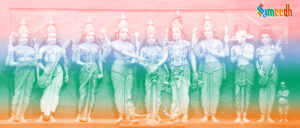In Hinduism, sacred images of the gods and goddesses are called murti and are a central part of home and temple worship. The use of idols, or murtis, in Hindu worship is a practice that has deep cultural, philosophical, and spiritual significance.

In a Hindu home, one or more murti are typically placed on a small altar and serve as visual tools for contemplating a particular attribute of the Divine. The murti is sanctified or made holy through a priestly blessing called Pran Prathista. Once sanctified, the image is incorporated into daily rituals (nitya) of prayer and meditation. The worship of idols is rooted in several Hindu beliefs and serves various purposes within the religion:
- Representation of the Divine:
- Hindus believe in an all-pervasive, formless, and transcendent ultimate reality known as Brahman. However, understanding and connecting with this abstract concept can be challenging for many. Idols serve as tangible representations or symbols of the divine, making it easier for devotees to focus their worship and devotion.
- Manifestations of Deities (Deva and Devi):
- Hinduism is rich in its pantheon of gods and goddesses, each representing different aspects of the divine. Idols are considered physical embodiments or manifestations of these deities, making it possible for devotees to establish a personal and tangible connection with the divine presence.
- Aids in Concentration and Meditation:
- Idols provide a focal point for concentration during worship and meditation. By gazing upon an image or sculpture, practitioners can more easily direct their thoughts and emotions towards the divine. This aids in cultivating a sense of concentration, devotion, and spiritual connection.
- Symbolism and Allegory:
- The images and symbols used in idols often carry deep symbolic meanings. For example, the various attributes, postures, and expressions of deities convey specific qualities or aspects of the divine. The stories associated with the deities also serve as moral and philosophical lessons.
- Bhakti (Devotional) Tradition:
- Hinduism places significant emphasis on bhakti, or devotional worship. Idols provide a tangible medium through which devotees can express their love, devotion, and gratitude to the divine. It is believed that the divine responds to the sincere devotion of the worshiper.
- Cultural and Ritual Significance:
- Idols are integral to many Hindu rituals and ceremonies. Whether it’s daily puja (worship), festive celebrations, or special occasions, the presence of idols is central to these practices. The rituals associated with idol worship help reinforce a sense of community and cultural identity among Hindu adherents.
- Multiplicity of the Divine:
- Hinduism acknowledges the multiplicity of the divine, with various deities representing different facets of the ultimate reality. Idols offer a way to approach the divine in its diverse manifestations, catering to the varying spiritual needs and preferences of individuals.
It’s important to note that while idols are a common feature in Hindu worship, not all Hindus engage in idol worship, and different sects and philosophical traditions within Hinduism may have varying perspectives on the use of idols. Additionally, the emphasis on the formless and form aspects of the divine can vary among different schools of thought within Hinduism.